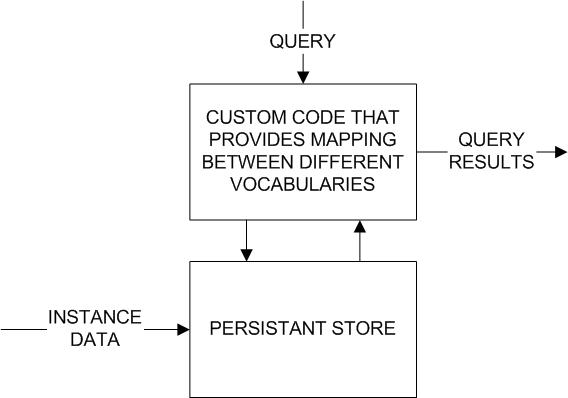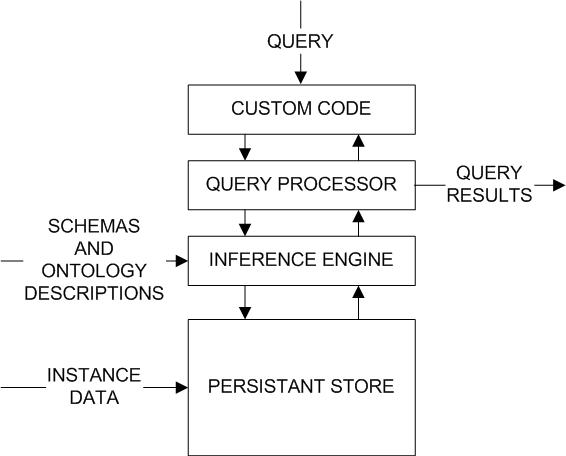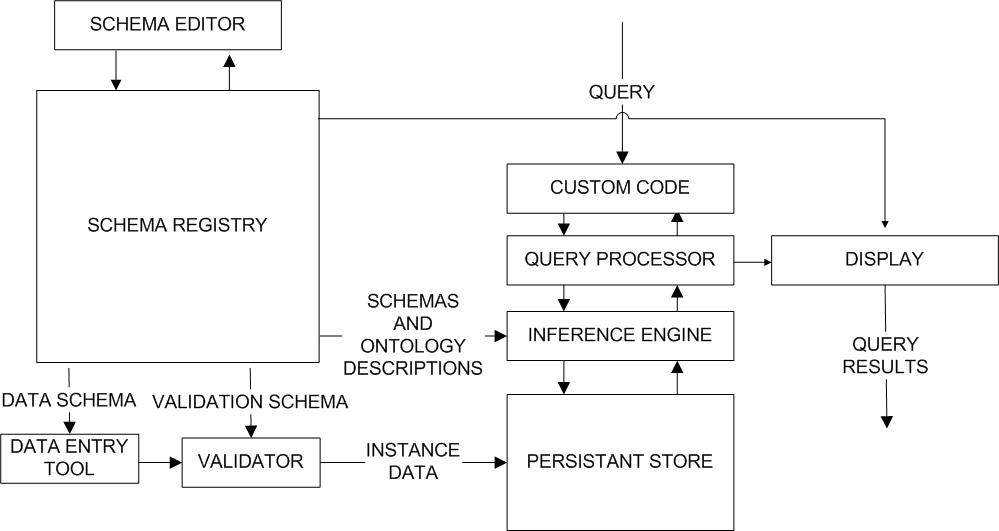- From: Seaborne, Andy <Andy_Seaborne@hplb.hpl.hp.com>
- Date: Mon, 4 Aug 2003 12:07:28 +0100
- To: "Butler, Mark" <Mark_Butler@hplb.hpl.hp.com>, "'www-rdf-dspace@w3.org'" <www-rdf-dspace@w3.org>
- Message-ID: <5E13A1874524D411A876006008CD059F07605A1D@0-mail-1.hpl.hp.com>
In talking with Mark, I understand there are two things being illustrated:
firstly, showing the area that SIMILE is addressing and secondly exploring
the architectural and engineering issues that arise.
Porting the OCLC demo (stage 1 below) is fine for the first. For the
second, we already have inferencing and query blocks so the architectural
exploration would just as easily be done in the context of stage 2 and fits
better with the planning we did at the plenary. The first stage may be just
extra work. Stage 2 woudl use the mapping rules we discussed as one of the
four items needed for introducing a new schema (schema itself, mapping
rules, display description and editing description (inc application
profile?)).
Then we could make the UI (the custom code in the second diagram) a separate
web service and use a network API to make queries (i.e. Joseki).
Presumably, this is the point Haystack would interface to the metadata side
of SIMILE.
The next step would to refine / refactor this to use schemas or ontologies
to map between different vocabularies, and use a query processor (RDQL) to
query the persistant store. This is shown in the diagram below:
Minor point: RDQL would be the query language, on top of the query processor
and inference modules in diagram 2. The Jena interface to persistent stores
isn't RDQL itself but is a lower-level conjunctive set of triple patterns.
- if so, does the team thing it is a worthwhile exercise to try to put a
very limited prototype as described in the first diagram, say over the next
month?
Yes - for showing the area SIMILE is operating in.
Andy
-----Original Message-----
From: Butler, Mark [mailto:Mark_Butler@hplb.hpl.hp.com]
Sent: 31 July 2003 17:41
To: www-rdf-dspace@w3.org
Subject: Staged demonstrators
Hi Team
Based on the plenary last week, I have a proposal about the first
demonstrator. I think it would be possible to build a demonstrator quite
quickly, based on the OCLC demo, that tries to solve the same problem of
using RDF to interoperate between different vocabularies. In OCLC demo the
mapping between different vocabularies is mainly done using custom code. The
big difference between the demo and the OCLC version is it would use a
persistant store. For more details see the diagram below:
The next step would to refine / refactor this to use schemas or ontologies
to map between different vocabularies, and use a query processor (RDQL) to
query the persistant store. This is shown in the diagram below:
Finally, the complete system would demonstrate tools for creating the
various declarative descriptions used by the system. It would also provide a
registry to manage different schemas as shown in the diagram below.
So my questions are:
- do these diagrams look reasonable (the Visio diagrams are in the
IPSSources CVS if you want to edit them)?
- if so, does the team thing it is a worthwhile exercise to try to put a
very limited prototype as described in the first diagram, say over the next
month?
kind regards,
Dr Mark H. Butler
Research Scientist HP Labs Bristol
mark-h_butler@hp.com
Internet: http://www-uk.hpl.hp.com/people/marbut/
<http://www-uk.hpl.hp.com/people/marbut/>
Attachments
- image/jpeg attachment: Demo_1.jpg

- image/jpeg attachment: Demo_2.jpg

- image/jpeg attachment: Demo_3.jpg

Received on Monday, 4 August 2003 07:08:22 UTC